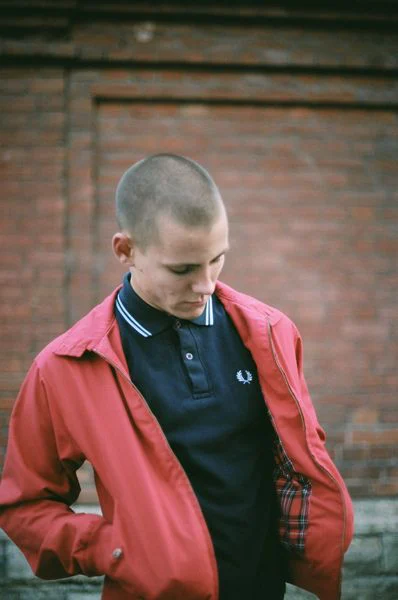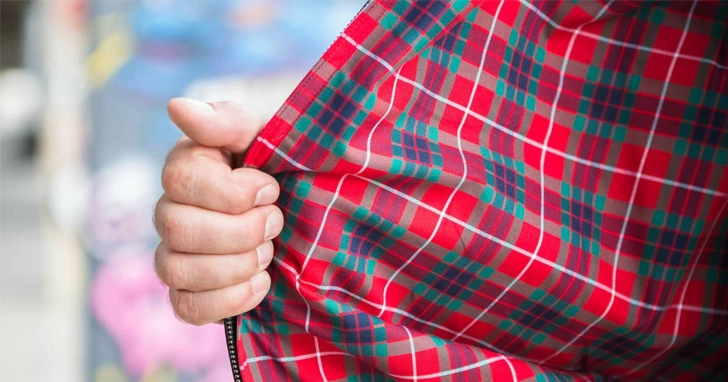There’s something about a Harrington jacket worn over a crisp white Fred Perry that just works. Ask any skinhead worth their boots — it’s not just about looking sharp, it’s about showing pride. From the terraces to the dancehalls, this simple jacket became a symbol of working-class attitude, identity, and defiance. But the story of the Harrington starts far from the streets — on golf courses and Ivy League campuses. So, how did a golfer’s jacket become a skinhead staple and a subcultural icon?
Born on the Green
The Harrington jacket didn’t start as a fashion statement. It was made for golf. Back in 1937, two brothers from Manchester, John and Isaac Miller, designed a lightweight, windproof jacket for their company, Baracuta. They named it the G9 — “G” for golf — and it was designed to help players stay dry and comfortable on the course without sacrificing style.

© Mazeclothing
What made the jacket special? A few clever details: a zip front, ribbed cuffs and hem, slanted buttoned pockets to keep things secure, and a smart stand-up collar with double buttons. But perhaps the most iconic feature was the inside — a bright red tartan lining borrowed from the Fraser clan in Scotland. The jacket was both practical and well-made, yet it also had a sharp, tailored look. It was British design at its best: clean, functional, and quietly stylish.

By the late 1940s and early ‘50s, the G9 started to catch on beyond the fairway. Its neat shape and lightweight build made it ideal for casual wear. But it took a trip across the Atlantic to take off.
The Ivy League Embrace
In the 1950s and early ‘60s, American college students — especially in the Ivy League — began to adopt the Harrington jacket as part of their everyday style. It fit perfectly with the East Coast preppy look: chinos, penny loafers, button-down shirts, and neat hairstyles. The jacket’s minimalist design made it versatile, and the tartan lining added just enough flair.

It was around this time that the G9 gained its nickname. In the American TV soap opera Peyton Place, the character Rodney Harrington, played by Ryan O’Neal, wore the jacket so often that people simply started calling it the Harrington. The name stuck, and the jacket became a quiet cult classic on both sides of the ocean.
Mods and the making of a British subculture icon
Back in Britain, something was brewing. In the early ‘60s, the Mod subculture began to rise. Mods were young, sharp, urban, and obsessed with fashion, music, and scooters. They wanted to dress well but stand out from their parents’ generation — and from the rockers in their greasy leathers. The Harrington jacket, with its tidy silhouette and slick detailing, fit the bill perfectly.
Mods wore Harringtons with tailored trousers, desert boots, and crisp shirts. It became part of their off-duty uniform — casual but clean, cool without trying too hard. The jacket’s slim fit matched their love for sharp lines and streamlined scooters. And like many Mod staples, it had American roots but a British twist.
Skinhead adoption
By the late ‘60s, a tougher offshoot of the Mod scene had arrived: the skinheads. This was a new kind of working-class youth — proud, bold, and often aggressive. Inspired by Mod style but with more grit, skinheads stripped things down and amped things up. The suits became jeans or sta-press trousers, the loafers became boots, and the carefully styled hair became a shaved head.
The Harrington jacket was a perfect match for this new attitude. Worn over a Fred Perry polo or a checked Ben Sherman shirt, with braces, jeans, and Dr. Martens boots, it became a key part of the skinhead look. It was practical, affordable, and tough — and it looked sharp. Whether heading to a football match or a reggae night at the local pub, the Harrington fit in.


It was during this time that the Harrington began to take on different meanings. For some, it was just about style and identity. For others, it became a political symbol — worn proudly, and sometimes aggressively. But regardless of the wearer’s leanings, the jacket had found its place: as a piece of true British streetwear.
From Punks to Britpop
The 1970s and ‘80s brought another wave of interest. Punk rockers and rude boys picked up the Harrington as a nod to its streetwise appeal. It showed up on the backs of The Clash and other punk icons, blending in with leather, studs, and safety pins. Ska revival bands like The Specials wore them too, tying the jacket to both Black and white working-class youth in the UK.

In the ‘90s, Britpop brought the Harrington back into the mainstream. Damon Albarn of Blur wore it on stage and in music videos. Liam Gallagher sported one with his trademark swagger. It was cool again — without losing its original sense of rebellion.
At the same time, fashion labels began to take notice. Designers reworked the Harrington in different fabrics, fits, and colours. High-street shops like Fred Perry, Merc, and Ben Sherman all released their own versions. Even brands like Burberry and Ralph Lauren had a go.
Today
Today, the Harrington jacket is still going strong. It’s worn by punks, mods, skinheads, scooter boys, indie kids, and everyday blokes who just want a decent jacket. It’s become a symbol of both rebellion and tradition — a bridge between clean-cut and counter-culture.
You’ll spot it at gigs, football matches, scooter rallies, and festivals. It works with jeans and trainers or trousers and loafers. It’s smart enough to wear out, but casual enough to chuck on every day. And best of all, it hasn’t changed much. The tartan lining is still there. The collar still pops. And it still carries a bit of attitude.
Whether you’re into Northern Soul, street punk, or just like your clothes to have some history, the Harrington jacket remains a British style icon. It started on the golf course, went through Ivy League campuses, and ended up in the heart of the subcultures that shaped youth culture for decades.
A jacket with no frills, plenty of bite, and more lives than a punk band on their tenth reunion tour — the Harrington still zips up a bit of history every time you put it on.
